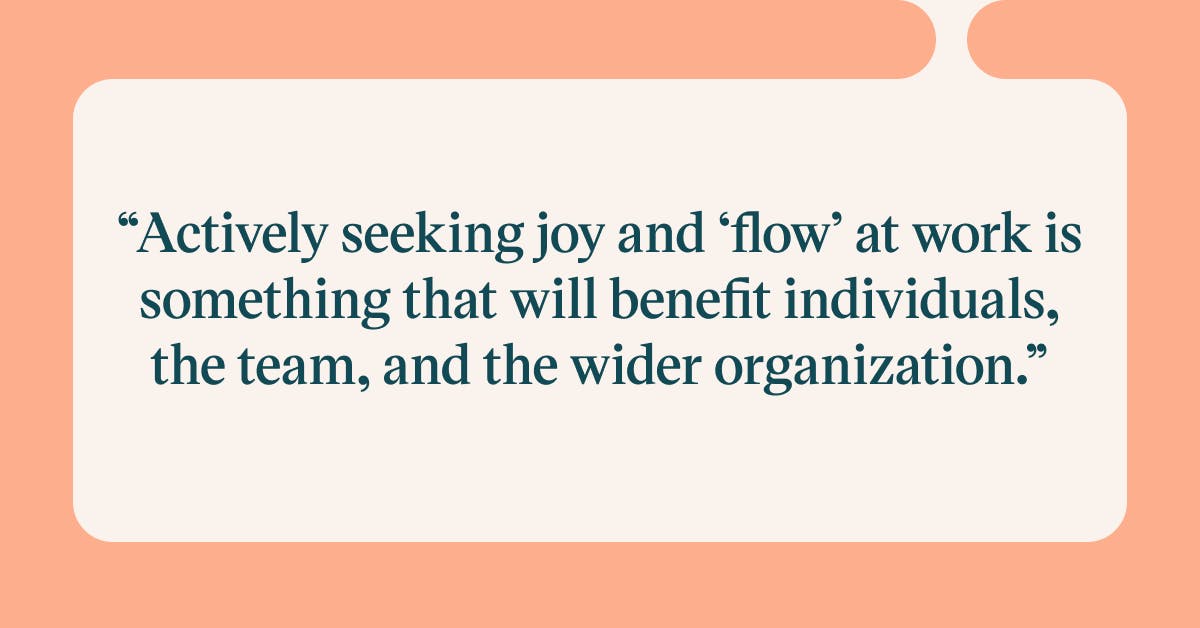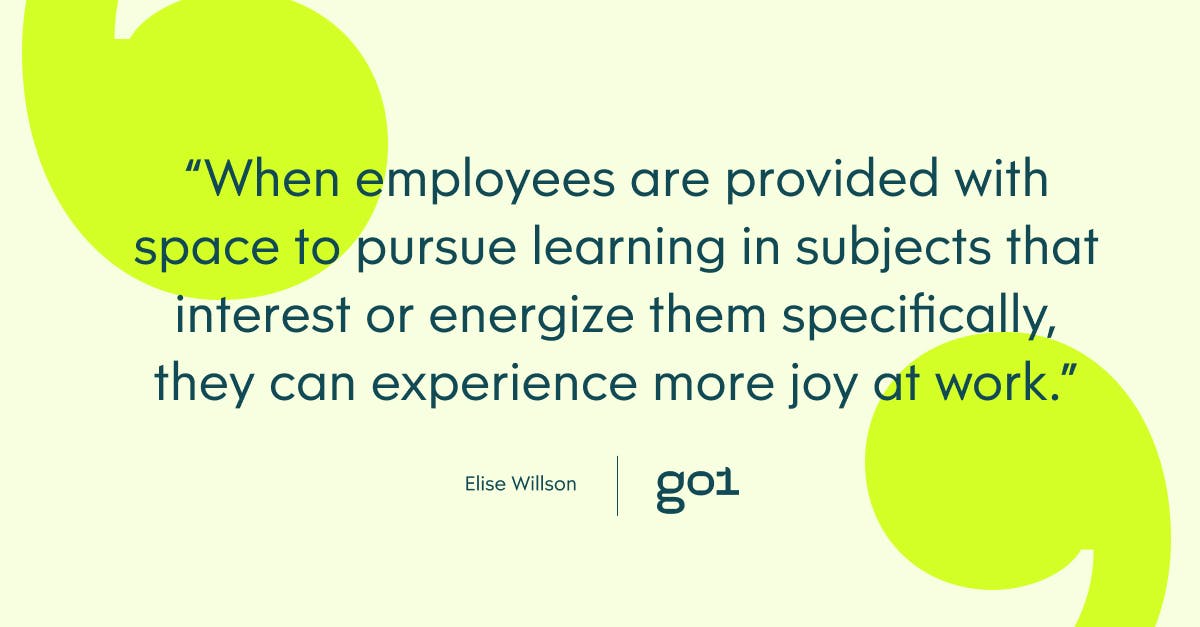Have you recently felt disconnected from feeling joy at work?
Within the context of the past two years, where organizational focus has been primarily on survival, seeking joy took a backseat for many employees. And now, as companies begin to emerge into post-pandemic life, leaders have limited time to facilitate joy again before their people start looking for more fulfilling opportunities elsewhere.
Research has shown how vital joy is to a person’s overall wellbeing, cognitive functioning and performance at work, as well as their retention.
To help us better understand the feeling of joy at work, and how to better facilitate it, we spoke to Thomas Cunningham-Fahie, Consultant and Psychologist at Bailey & French.
Is it possible to lose joy in a job you love?
Barbara Fredrickson, currently based at the University of North Carolina, is one of the world’s leading researchers into the psychology of emotions. Her ‘Broaden and Build Theory’ is based upon research showing that experiencing more positive emotions broaden our mindset and encourage us to be more creative, explore new thoughts and reach solutions more readily which overtime builds our skills and resources.
These emotions can gain momentum, creating positive upward spirals that lead to experiencing even more positive emotions.
In contrast, negative emotions are linked to the ‘fight or flight’ response, which narrows our cognitive capacity. Therefore, it’s near impossible to solve problems and overcome challenges when we are feeling stressed or frustrated… I’m sure this resonates with many of us!
There are also negative spirals of emotion. A big risk for losing joy in a job that you love, is if negative emotions caused by an event outside of work spiral and spill into how you feel at work.
We might also lose joy in a job we love if we stop playing to our strengths. By ‘strengths’, we’re not just talking about the things that we’re good at, but also the things that we enjoy and that energise us.
Playing to our strengths when executing tasks at work helps us to get into a state of flow. Mihaly Csikszentmihalyi, the psychologist who coined the term flow, defines it as: “the state in which people are so involved in an activity that nothing else seems to matter”.
Luckily, we are able to reframe most tasks and skills to use at least one of our top strengths. Therefore, if we do find ourselves losing joy in a job we previously loved, this type of reframing should be our first port of call.

Whose responsibility is it to facilitate ‘joy’ at work? Leaders or employees?
We’ve already discussed the Broaden and Build Theory, and how we can find ourselves on upward or downward emotional spirals. In teams and organisations, these upward spirals can spread. This is called emotional contagion, and it has an important impact of people’s wellbeing, resilience, and performance at work.
There is an old cliché in the management consulting world that ‘culture is everyone’s responsibility’. We would add a nuance to this, and then apply the same thinking to ‘joy’ at work. Doing what you can to make a personal contribution to a positive culture, is everyone’s responsibility.
Similarly, we are responsible for making the effort to facilitate a more positive, human experience at work. We are not, however, responsible for the emotions themselves of our colleague’s emotions.
It is about the personal effort we make as an individual within the organization, but ultimately not the outcome.
Since we know that emotions triggered by events outside of work are likely to spill into how we feel at work, it is not realistic to ask leaders or employees to ensure that their colleagues experience joy in the office.
What we can, and should, request is that everybody is held responsible for their actions and their intent towards facilitating joy, with the understanding that there will be external factors outside of their control that may ultimately impede the joy their workmates feel daily.
Taking individual responsibility for contributing to the joyful experience of others can follow two forms:
- By managing our own wellbeing and positive emotions, firstly to help ourselves but also to have a positive knock-on benefit for others through emotional contagion.
- Actively considering how you can help others to experience more positive emotions, through the way you collaborate and interact with them.
It is everyone’s responsibility to do this, but leaders particularly need to recognise that their position increases the influence that they have over the quality of people’s experiences within an organization.
Could seeking ‘joy at work’ be considered indulgent or selfish within the context of the last two years?
Since we have already discussed the benefits of positive emotions for the person experiencing them for their own wellbeing and performance, and for the people around them, the simple answer here is ‘no’.
More often than not, actively seeking joy and ‘flow’ at work is something that will benefit individuals, the team, and the wider organization, through a variety of different mechanisms.
One way of mapping out the time we spend at work is by using a Time x Energy Grid. For every task that we perform at work, we can assess how much it benefits us and how much it benefits the organization, then plot it on a 2x2 grid.

This grid helps us to understand that usually, it is not indulgent or selfish to seek joy at work. The activities in which we are most likely to experience joy falls into either the ‘Peak Performance’ or ‘Booster Time’ quadrants on the Time x Energy Grid. As such, there is either a direct benefit for the organization or an indirect benefit, respectively, since we are keeping our performance and productivity at its best.
The small caveat here is that, of course, this could become detrimental if too much of our time is spent performing tasks that energize us but are not directly beneficial for the organisation. Nevertheless, these tasks are still a better use of time than those which do not energize us (we would call these ‘Wasted Time’).
If we are working in a way that is harmful for our colleagues, either by facilitating negative emotions for them or adding to their workload, for example, then we might be considered self-indulgent. However, the antidote to this is an open feedback culture and strengths-based delegation within teams, to maximise the time that each member spends in their own version of peak performance.

How can we apply these insights to bring more joy to our team?
With Thomas' insights above we can begin to understand not only the nuances of experiencing joy, but how an organization can help facilitate this emotion for their people.
Focus your delegations on not only what your team are good at, but also what they enjoy and what energizes them. Playing to these strengths can assist in bringing flow and joy to their work life.
Rebecca Newton, Organizational and Social Psychologist, finds many of her clients link joyful moments to learning experiences at work. When employees are provided space to pursue learning in subjects that interest or energize them specifically, they can experience more joy at work.
As Thomas noted as well, home life can easily affect the emotions of employees at work. Looking after your team as ‘whole life employees’ takes empowering levels of empathy (which we delved into in our article Learning to lead with empathy) and involves supporting their overall wellbeing, not just their job performance.
To assist you and your team in developing a comprehensive workplace wellbeing plan, we have curated a free The search for joy at work playlist of learning resources within the Go1 platform.
The playlist includes learning content from iAM Learning, Blinkist and Thrive Learning and other mental health providers. If you are already a Go1 customer, you can recreate this playlist in your own LMS or Go1 Platform. If you are not yet a customer, click on the link above to access the playlist. If you're interested in the Go1 Content Hub for your organization's wellbeing and L&D goals, please get in touch with us today.
Please remember, if you are struggling with your mental health and experiencing significant distress, we encourage you to reach out for immediate support.
Australia: Lifeline 131 114 or Beyond Blue 1300 224 636
USA: NAMI HelpLine 800-950-6264
UK: Samaritans 116 123 or Shout Crisis Text Line text ‘SHOUT’ to 85258
Global: United for Global Mental Health Regional Directory






